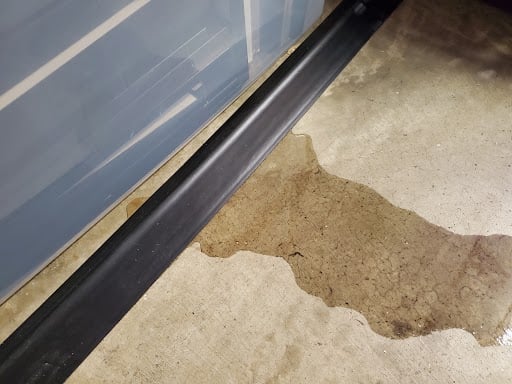The Hard Truths:
Guide to Concrete Slab Moisture Testing With a Hygrometer
Go to the lowest level of virtually any modern structure – be it a home or skyscraper – and you’ll find the same building material. The same goes for the floors of many large single-story commercial buildings or industrial structures.
Concrete.
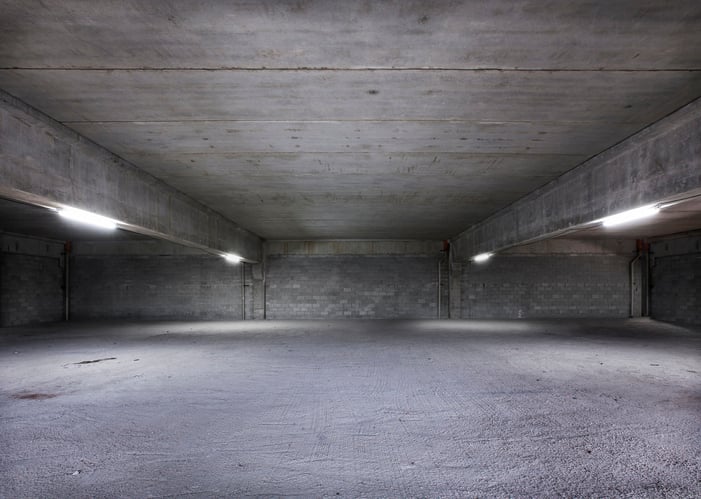 That should come as no surprise. As one of the oldest building materials (yes, it can be found in buildings and even roads from centuries ago), concrete has earned its rightful place in construction. Durable, robust, and customizable, concrete delivers a level of long-term performance that’s hard to beat.
That should come as no surprise. As one of the oldest building materials (yes, it can be found in buildings and even roads from centuries ago), concrete has earned its rightful place in construction. Durable, robust, and customizable, concrete delivers a level of long-term performance that’s hard to beat.
But in another sense, a seemingly less likely, yet common substance can compromise the strong and resilient building material.
Moisture – primarily when it’s in vapor form.
With the ability to pass through concrete invisible to the naked eye, moisture can be a concrete slab’s undoing. The same goes for flooring installed overtop a slab.
How do you prevent moisture from getting the better of a concrete slab and creating bigger issues? By being proactive and checking concrete for moisture presence.
When it comes to measuring moisture in concrete floors and slabs, there’s a myth that persists: You’ll only need a concrete moisture meter.
That perception is half correct. Yes, a concrete moisture meter is good to have on hand for evaluations. But, no, it’s not the only type of meter you’ll need. Additionally, a concrete moisture meter plays a supporting role in concrete slab moisture testing.
So what do you use and how do you take accurate and representative readings?
Let’s dig into the hard truths about concrete moisture meters and measuring moisture in concrete.
The Best Moisture Meter for Concrete
(Spoiler: It’s Not a Traditional Moisture Meter)
What’s the best moisture meter for concrete?
The answer is simple. It’s not a traditional moisture meter, per se (think pinless or pin-type meters), nor is it a concrete moisture meter.
Rather, the best type of moisture meter for concrete is a hygrometer.
Before we dig much deeper into that answer, let’s take a look at the relationship concrete has with moisture, particularly with concrete floors and slabs.
Concrete Floors and Moisture: The Tension of Opposites
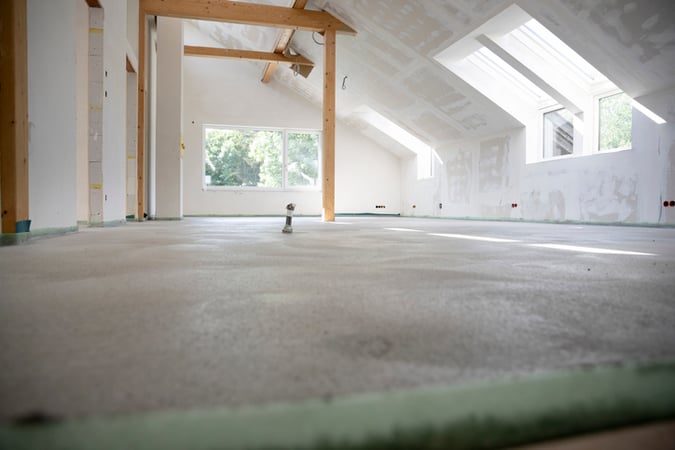 By appearances, concrete floors and moisture should have a very one-sided relationship. Concrete is strong and durable, so moisture shouldn’t be much of an issue, right?
By appearances, concrete floors and moisture should have a very one-sided relationship. Concrete is strong and durable, so moisture shouldn’t be much of an issue, right?
Wrong.
On one hand, concrete needs moisture – it’s impossible to make the material without adding water. And moisture is a key component of a successful curing process – without it at the right levels at the right times, a concrete slab can lose strength and integrity as it hardens.
At the same time, moisture can be one of the worst things for a concrete slab.
Because of their aggregate and cement compositions, some concrete floors are porous and allow moisture – typically as a vapor – to travel through if there’s an ineffective moisture barrier. In other instances, if a concrete slab did not equilibrate to its environment during curing, moisture can get trapped inside and later escape.
In either case, what does that mean for the slab and flooring? You likely see damage:
|
To The Slab |
To Flooring Overtop a Slab |
| • Discoloration • Rising salts (efflorescence) • Brittleness • Irreparable damage – cracks, pitting |
• Tile tenting • Cracking, warping, cupping • Staining (primary carpets) • Mold and mildew |
Moisture can lead to issues far beneath the slab’s surface, causing structural soil degradation, in which the soil the slab is atop loses its load-bearing capabilities and cannot support the concrete.
Regardless of how moisture damage presents itself or to what extent, recovering from a moisture issue is often a very expensive and time-consuming ordeal.
Untested Concrete Slabs: A Recipe for Disaster
Put yourself in a client’s shoes for a moment.
Imagine you’re the owner of a local chain of hardware stores. Your company is in growth mode and you’re building new locations throughout your home region – all of which have concrete slabs as their foundations.
A few weeks after your newest location opened, a manager calls saying that a large area of tile flooring has lifted and cracked.
Unfortunately, this will mean shutting down a substantial area of the store to diagnose and fix the issue.
What’s more unfortunate – this could have been prevented.
As it turns out, had a simple concrete slab moisture test been administered, the results would have shown a moisture issue that could have been addressed long before the flooring was installed. Now, you’re essentially on the hook for a major – and likely expensive – renovation.
Suffice it to say, one of the worst things any property owner or flooring installer can do is not test a concrete slab for moisture before installing flooring. Without proper testing, you’re rolling the dice that a small moisture issue won’t become a bigger problem later on.
Hygrometers as Your Concrete Moisture Meter
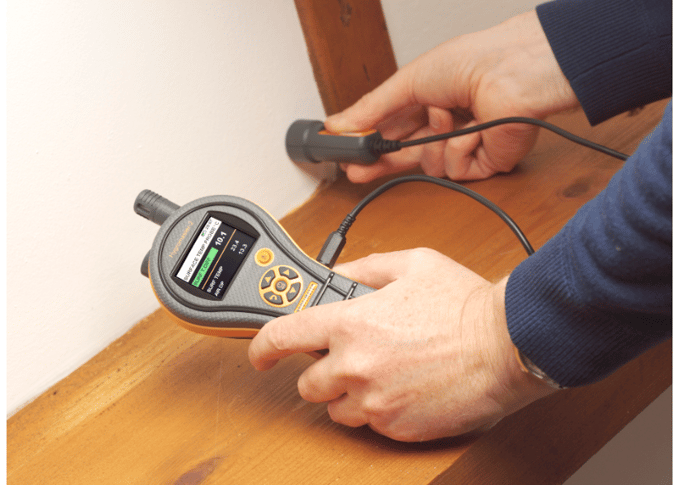
Back to our answer – hygrometers for testing moisture in concrete.
Why hygrometers as a concrete floor moisture meter?
Because of the type of measurements they take and how they take them.
But let’s back up, why aren’t standard moisture meters, both pin-type and pinless, the best options for concrete slab moisture tests?
Because of how the types of measurements both take and how they take them.
While the surface of a concrete slab may test as wet with a pin-type meter, the readings don’t go much deeper into the actual moisture conditions inside the slab as testing with a hygrometer does. At best, a pin-type meter’s readings (which rely on electrical conductivity) on concrete are quite literally surface-level and don’t account for the metric hygrometer’s measure for – water vapor presence. In other words, you can’t use a pin-type meter to measure moisture in a concrete slab.
Pinless (non-invasive) meter readings run into the same issue for moisture tests on concrete slabs. While they can help an inspector quickly locate an area of concern, they give a qualitative reading for moisture presence potential within their depth of measurement. What’s more, their readings always require further investigation by a pin-type meter to confirm.
What’s more, both meter types simply can’t tell you about the aggregate mixture comprising the concrete slab. Much like an unseen metal pipe or wire, some ingredients used in concrete impact its electrical properties. That means when taking a reading with either meter type, there’s a good chance you might get a false-positive measurement for excessive moisture that isn’t actually there. Compounding matters more, because of the unknown about a slab’s composition, it’s nearly impossible to create a calibration for either meter type to ensure accuracy.
Can Pin-Type & Pinless Moisture Meters Be Used to Inspect Concrete for Moisture?Yes! As long as they’re used with the right intention.
And FYI – “concrete moisture meters” – both pinless and pin-type – do exist. However, it’s important to note that meters touted as concrete moisture meters function the same as their non-concrete meter counterparts, only taking readings from the slab’s surface. And their measurements? They aren’t accepted by the American Society for Testing and Materials (ASTM) as an accurate assessment of moisture within a concrete slab. |
Hygrometers, however, measure relative humidity (Rh), a reading that’s collected from inside the slab.
While it may seem counterintuitive to gauge moisture presence in a slab by measuring humidity, it’s actually the most accurate and reliable way.
[How to] Measuring Moisture in Concrete Slabs: The Method
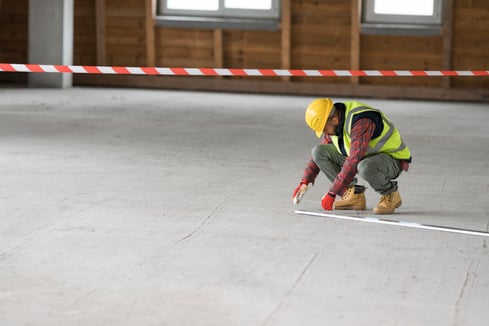
Unlike both types of moisture meters, hygrometer readings don't rely on electrical conductivity or radio waves. Hygrometer Rh readings are captured from inside a concrete slab, using the in situ method.
Considered the go-to method for evaluating moisture presence in concrete slabs, in situ uses specialized hygrometer probes placed in holes drilled into the slab (which are sealed and left for 24 hours), to measure water vapor passing through the material. Readings collected are expressed as an Rh percentage. Like all other measurements taken on a hygrometer, the higher the percentage, the higher the moisture presence.
Why is the in situ method preferred for concrete slab moisture testing?
A few reasons:
- By taking measurements from inside a slab, you can create a controlled microenvironment that’s not affected by external factors (say, a change in a room's humidity) that can give false-positive readings.
- Moisture moves through concrete at a gradient, and thus getting representative of moisture presence requires gathering data from multiple points. The in situ method using the ASTM F-2170 standard (more on this later) sets the minimum number of probe insertions needed per 1,000 square feet.
- The moisture you can't see usually poses the biggest problem for a slab. And incidentally, that’s what you’re trying to measure for. In the case of concrete, it’s the water vapor that’s trapped inside from improper curing or an overly porous slab that allows water to travel through it.
In situ testing takes less time than other methods – 24 hours to complete a test. That’s much shorter than other concrete moisture tests (some can take most of a week) What’s more, in situ testing can go on as long as needed, so long as the microenvironments the probes are protected & undisturbed.
[How to] Measuring Moisture in Concrete Slabs: The Practice
See In Situ in Action: Peter Craig of Concrete Constructives demonstrates the in situ method for concrete slab moisture testing with a Protimeter Concrete Flooring Kit:
Putting the in situ method for concrete Rh testing method to work is a straightforward process.
After identifying an area of concern within a concrete slab, follow these seven steps (which are in accordance with the ASTM F-2170):
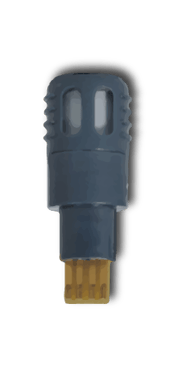 After using a pinless meter to locate areas with the highest potential for moisture, drill three holes for the first 1,000 square feet in the area of a concrete slab being investigated to a depth equal to 40% of the slab’s thickness. You’ll need another one hole per 1,000 square feet after.
After using a pinless meter to locate areas with the highest potential for moisture, drill three holes for the first 1,000 square feet in the area of a concrete slab being investigated to a depth equal to 40% of the slab’s thickness. You’ll need another one hole per 1,000 square feet after. - Clear the holes of dust and debris – use a wire brush to free up any loose particulate and then vacuum each opening.
- Visually inspect the bottom of each hole to make sure you haven’t drilled into the heart of a piece of coarse aggregate (e.g. gravel). If more than half of the hole’s base is coarse aggregate, drill a new opening.
- Set your Rh probe sleeves to the correct depth and insert them into each hole.
- Insert NIST traceable Rh probes into their respective sleeves and place a cap to seal each opening.
- Wait 24 hours for the probes to equilibrate with their microenvironment’s Rh.
- After 24 hours, take & record Rh readings using a hygrometer.
Hygrometer Probe Selection for Concrete Rh Testing
When selecting hygrometer probes for a concrete floor moisture test, you’ll face two choices: reusable and disposable.
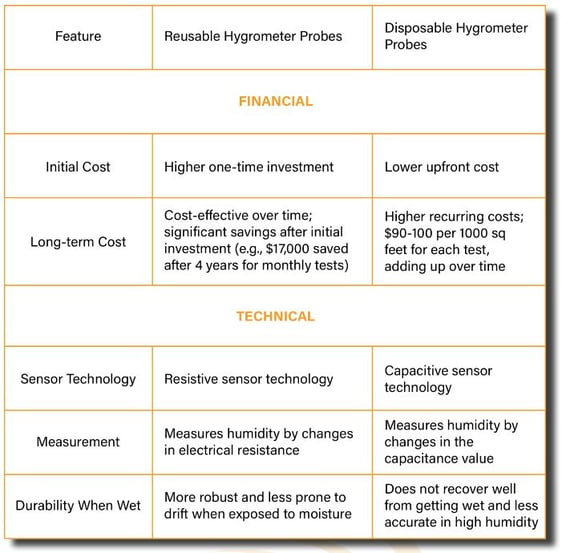 What’s the difference between both types – aside from the obvious that one gets thrown out after one use?
What’s the difference between both types – aside from the obvious that one gets thrown out after one use?
It comes down to two key factors: cost and functionality.
On the cost front, it comes down to simple math. While a reusable probe does cost more upfront, what you’re initially spending ends up being a long-term investment. As they’re designed to do, reusable probes have a long, useful life – lasting around four years. Disposable probes are only good for one test before requiring replacement. In a certain respect, this is no different than reusable batteries vs. disposable batteries for your favorite electronics.
Consider this scenario: If you complete one concrete Rh testing job a month using 12 test holes each, reusable probes start to pay for themselves in a big way. In just a few years, you’d save a significant amount of money than if you had used disposable probes that require replacement after each use.
On the functionality front, reusable probes typically use resistive sensors, which measure humidity by detecting electrical resistance changes due to moisture, offering robust performance even when wet. On the other hand, disposable probes employ capacitive sensors, which gauge humidity by measuring changes in capacitance caused by variations in a material's dielectric constant due to moisture. While capacitive sensors are widely used, they are less reliable when wet, often losing accuracy and are prone to drift in high humidity conditions.
Acceptable Moisture Levels in Concrete Floors
After waiting at least 24 hours from the start of the test, your probe readings should show an Rh measurement of 75-90% or less.
Anything beyond that threshold is almost a guarantee that the flooring – be it tile, laminate, hardwood, or even carpet – will eventually be affected by moisture and damaged
What happens immediately when test results show excessive Rh?
For the flooring contractor, it means work doesn't start until the issue is handled. It's up to the property owner to work toward a solution to eliminate the excessive moisture from the slab. Options include:
- Giving the slab more time to cure
- Running a dehumidifier to encourage water vapor release
- Sealing the slab's surface
- Starting a deeper investigation into the source of the moisture
The ASTM F-2170 Vs. Other Concrete Slab Moisture Testing Methods
We’ve mentioned the ASTM F-2170 a few times. And chances are, you’ve probably heard of it when looking into testing moisture in concrete.
What is it exactly?
The ASTM F-2170 is the standard method for measuring moisture in concrete slabs using in situ tests for Rh.
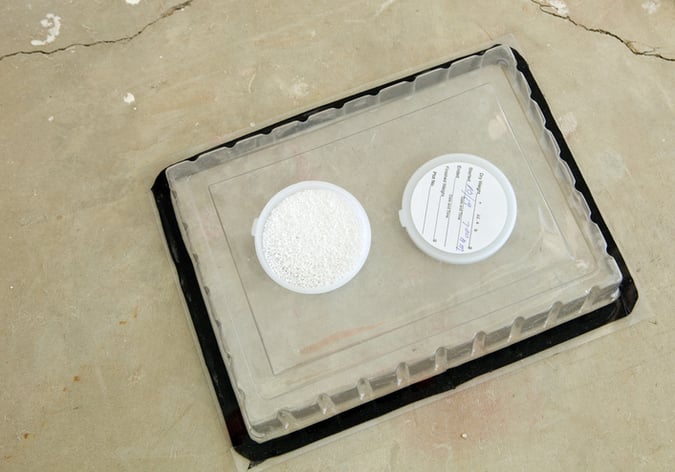 Comparatively speaking, testing concrete moisture levels via Rh measurements is a newer methodology. Though it was used in Europe for several decades prior, Rh testing in concrete was first brought to the U.S. in 1999, and published two years later as the ASTM F-2170.
Comparatively speaking, testing concrete moisture levels via Rh measurements is a newer methodology. Though it was used in Europe for several decades prior, Rh testing in concrete was first brought to the U.S. in 1999, and published two years later as the ASTM F-2170.
Where did this method to gauge moisture presence in concrete come from? The need for a more accurate – and consistent – means to take measurements.
While there were several different ways to measure moisture in concrete after it’s cured, many inspectors relied on the calcium chloride method. This type of test involves putting an anhydrous calcium chloride crystal (a salt) onto the surface of concrete and waiting at least 72 hours. During that time, the crystal absorbs moisture and becomes heavier. At the end of the test, the crystal is weighed. Should the crystal weigh more, that confirms the presence of moisture.
But therein lies the problem – it doesn't delineate between the source of said moisture.
So, for instance, on a dry day, you have higher vapor pressure, allowing more moisture to be drawn to the surface and into the testing kit, thereby giving an inaccurate representation of moisture presence.
When administered correctly, the ASTM F-2170 standard of measuring moisture in concrete eliminates this issue and provides for more accurate results.





